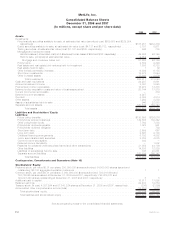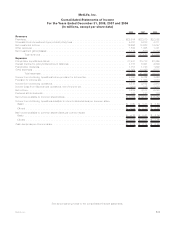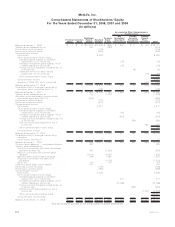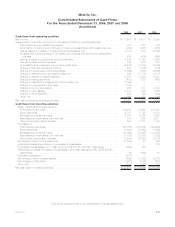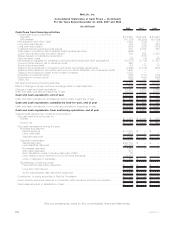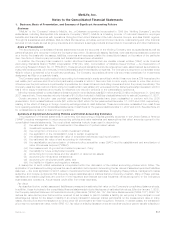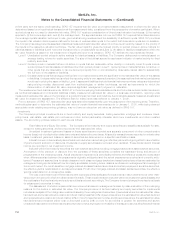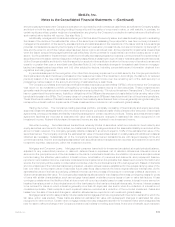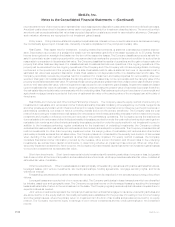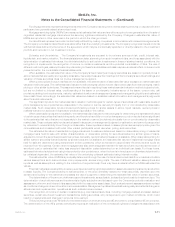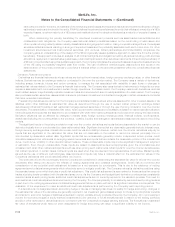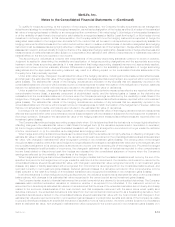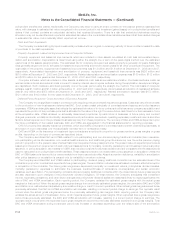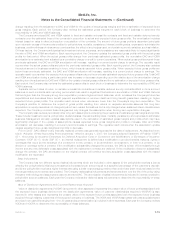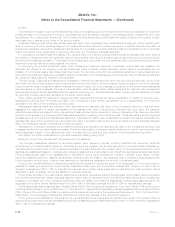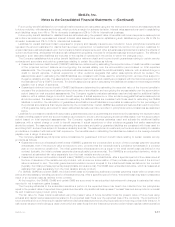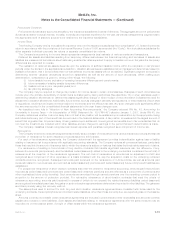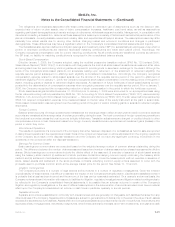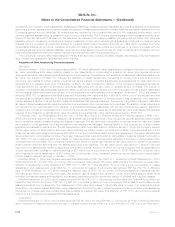MetLife 2008 Annual Report Download - page 135
Download and view the complete annual report
Please find page 135 of the 2008 MetLife annual report below. You can navigate through the pages in the report by either clicking on the pages listed below, or by using the keyword search tool below to find specific information within the annual report.each party involved in the entity, an estimate of the entity’s expected losses and expected residual returns and the allocation of such
estimates to each party involved in the entity. FIN 46(r) defines the primary beneficiary as the entity that will absorb a majority of a VIE’s
expected losses, receive a majority of a VIE’s expected residual returns if no single entity absorbs a majority of expected losses, or
both.
When determining the primary beneficiary for structured investment products such as asset-backed securitizations and
collateralized debt obligations, the Company uses historical default probabilities based on the credit rating of each issuer and
other inputs including maturity dates, industry classifications and geographic location. Using computational algorithms, the analysis
simulates default scenarios resulting in a range of expected losses and the probability associated with each occurrence. For other
investment structures such as trust preferred securities, joint ventures, limited partnerships and limited liability companies, the
Company gains an understanding of the design of the VIE and generally uses a qualitative approach to determine if it is the primary
beneficiary. This approach includes an analysis of all contractual rights and obligations held by all parties including profit and loss
allocations, repayment or residual value guarantees, put and call options and other derivative instruments. If the primary beneficiary of
a VIE can not be identified using this qualitative approach, the Company calculates the expected losses and expected residual returns
of the VIE using a probability-weighted cash flow model. The use of different methodologies, assumptions and inputs in the
determination of the primary beneficiary could have a material effect on the amounts presented within the consolidated financial
statements.
Derivative Financial Instruments
Derivatives are financial instruments whose values are derived from interest rates, foreign currency exchange rates, or other financial
indices. Derivatives may be exchange-traded or contracted in the over-the-counter market. The Company uses a variety of derivatives,
including swaps, forwards, futures and option contracts, to manage the risk associated with variability in cash flows or changes in
estimated fair values related to the Company’s financial instruments. The Company also uses derivative instruments to hedge its currency
exposure associated with net investments in certain foreign operations. To a lesser extent, the Company uses credit derivatives, such as
credit default swaps, to synthetically replicate investment risks and returns which are not readily available in the cash market. The Company
also purchases certain securities, issues certain insurance policies and investment contracts and engages in certain reinsurance contracts
that have embedded derivatives.
Freestanding derivatives are carried on the Company’s consolidated balance sheet either as assets within other invested assets or as
liabilities within other liabilities at estimated fair value as determined through the use of quoted market prices for exchange-traded
derivatives and financial forwards to sell residential mortgage backed securities or through the use of pricing models for over-the-counter
derivatives. The determination of estimated fair value, when quoted market values are not available, is based on market standard valuation
methodologies and inputs that are assumed to be consistent with what other market participants would use when pricing the instruments.
Derivative valuations can be affected by changes in interest rates, foreign currency exchange rates, financial indices, credit spreads,
default risk (including the counterparties to the contract), volatility, liquidity and changes in estimates and assumptions used in the pricing
models.
The significant inputs to the pricing models for most over-the-counter derivatives are inputs that are observable in the market or can be
derived principally from or corroborated by observable market data. Significant inputs that are observable generally include: interest rates,
foreign currency exchange rates, interest rate curves, credit curves and volatility. However, certain over-the-counter derivatives may rely on
inputs that are significant to the estimated fair value that are not observable in the market or cannot be derived principally from or
corroborated by observable market data. Significant inputs that are unobservable generally include: independent broker quotes, credit
correlation assumptions, references to emerging market currencies and inputs that are outside the observable portion of the interest rate
curve, credit curve, volatility or other relevant market measure. These unobservable inputs may involve significant management judgment
or estimation. Even though unobservable, these inputs are based on assumptions deemed appropriate given the circumstances and
consistent with what other market participants would use when pricing such instruments. Most inputs for over-the-counter derivatives are
mid market inputs but, in certain cases, bid level inputs are used when they are deemed more representative of exit value. Market liquidity
as well as the use of different methodologies, assumptions and inputs may have a material effect on the estimated fair values of the
Company’s derivatives and could materially affect net income.
The credit risk of both the counterparty and the Company are considered in determining the estimated fair value for all over-the-counter
derivatives after taking into account the effects of netting agreements and collateral arrangements. Credit risk is monitored and
consideration of any potential credit adjustment is based on a net exposure by counterparty. This is due to the existence of netting
agreements and collateral arrangements which effectively serve to mitigate credit risk. The Company values its derivative positions using
the standard swap curve which includes a credit risk adjustment. This credit risk adjustment is appropriate for those parties that execute
trades at pricing levels consistent with the standard swap curve. As the Company and its significant derivative counterparties consistently
execute trades at such pricing levels, additional credit risk adjustments are not currently required in the valuation process. The need for
such additional credit risk adjustments is monitored by the Company. The Company’s ability to consistently execute at such pricing levels is
in part due to the netting agreements and collateral arrangements that are in place with all of its significant derivative counterparties. The
evaluation of the requirement to make an additional credit risk adjustments is performed by the Company each reporting period.
If a derivative is not designated as an accounting hedge or its use in managing risk does not qualify for hedge accounting, changes in
the estimated fair value of the derivative are generally reported in net investment gains (losses) except for those (i) in policyholder benefits
and claims for economic hedges of liabilities embedded in certain variable annuity products offered by the Company, (ii) in net investment
income for economic hedges of equity method investments in joint ventures, or for all derivatives held in relation to the trading portfolios
and (iii) in other revenues for derivatives held in connection with the Company’s mortgage banking activities. The fluctuations in estimated
fair value of derivatives which have not been designated for hedge accounting can result in significant volatility in net income.
F-12 MetLife, Inc.
MetLife, Inc.
Notes to the Consolidated Financial Statements — (Continued)


